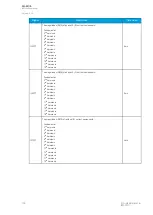
Table. 5.3.5 - 75. Register content.
Register
Description
Event code
dd.mm.yyyy hh:mm:ss.mss
Date and time
5184-5389 Descr.
I
0
pre-triggering current
Start/Trip -20ms current
I
0
fault current
Start/Trip current
Fault capacitive I
0
Start/Trip capacitive current
Fault resistive I
0
Start/Trip resistive current
Fault U
0
(%)
Start/Trip voltage (percentage of nominal)
Fault U
0
(V)
Start/Trip voltage (in Volts)
I
0
fault angle
0...360°
Trip time remaining
0 ms...1800s
Used SG
Setting group 1...8 active
Network GND
Unearthed, Petersen coil earthed, Earthed network
I
0
pre-fault current
Start -200ms current
5.3.6 Negative sequence overcurrent/ phase current reversal/ current unbalance
protection (I2>; 46/46R/46L)
The current unbalance function is used for instant and time-delayed unbalanced network protection
and for detecting broken conductors. The number of stages in the function depends on the
relay model. The operating decisions are based on negative and positive sequence current magnitudes
which the function constantly measures. In the broken conductor mode (I2/I1) the minimum allowed
loading current is also monitored in the phase current magnitudes.
There are two possible operating modes available: the I2 mode monitors the negative sequence
current, while the I2/I1 mode monitors the ratio between the negative sequence current and the
positive sequence current. The relay calculates the symmetrical component magnitudes in use from
the phase current inputs
I
L1
,
I
L2
and
I
L3
. The zero sequence current is also recorded into the registers
as well as the angles of the positive, negative and zero sequence currents in order to better verify any
fault cases. The blocking signal and the setting group selection control the operating characteristics of
the function during normal operation, i.e. the user or user-defined logic can change function
parameters while the function is running.
The outputs of the function are the START, TRIP and BLOCKED signals. The current unbalance
function uses a total of eight (8) separate setting groups which can be selected from one common
source.
The function can operate on instant or time-delayed mode. In time-delayed mode the operation can be
selected between definite time (DT) or inverse definite minimum time (IDMT). The IDMT operation
supports both IEC and ANSI standard time delays as well as custom parameters.
The operational logic consists of the following:
• input magnitude selelction
• input magnitude processing
• threshold comparator
• block signal check
• time delay characteristics
• output processing.
A
AQ
Q-F205
-F205
Instruction manual
Version: 2.04
130
© Arcteq Relays Ltd
IM00013
Summary of Contents for AQ F205
Page 1: ...AQ F205 Feeder protection IED Instruction manual ...
Page 2: ......
















































